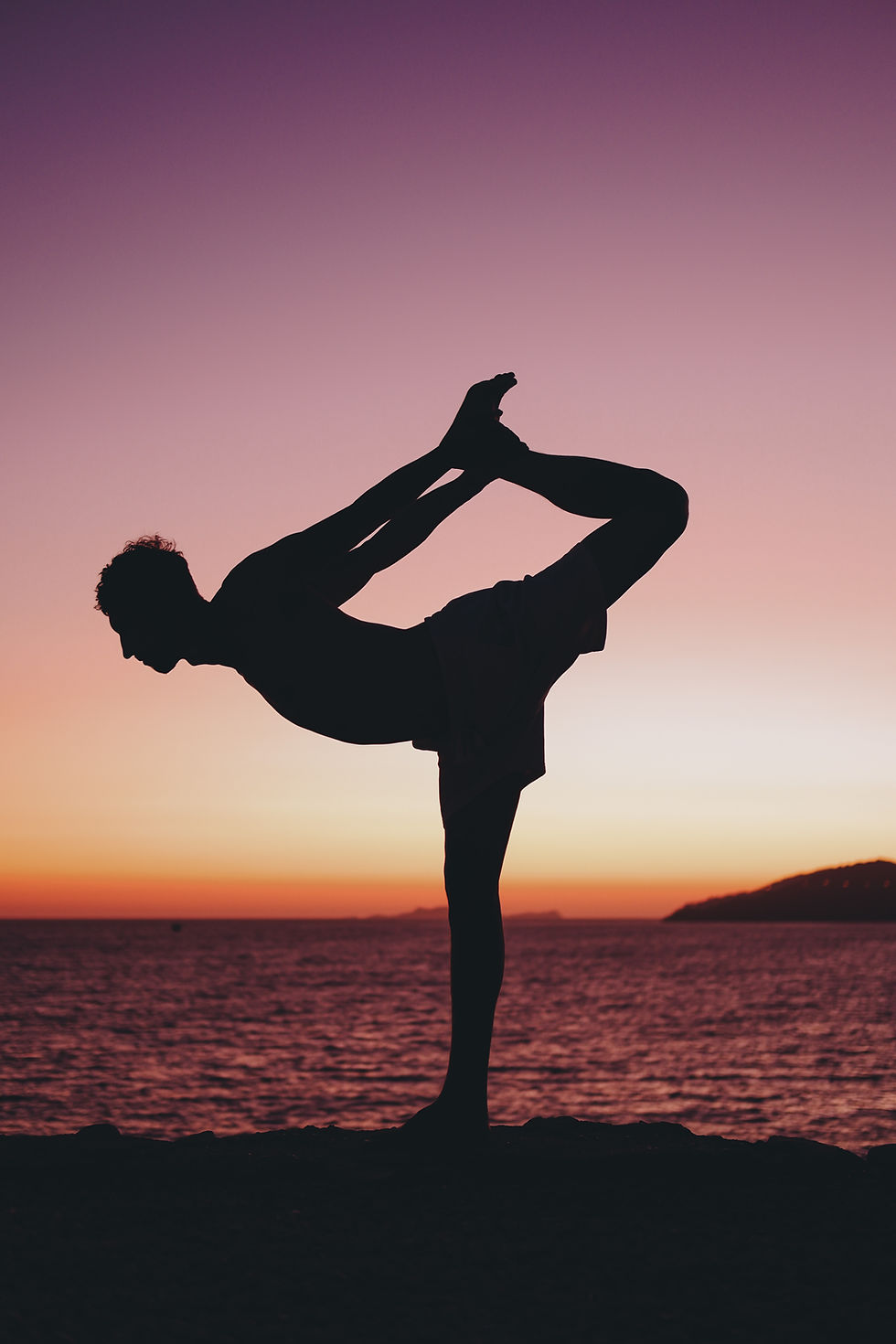Yoga for Cardiac Health: A Calming Path to Recovery and Strength
- Jamie Pickett

- Aug 2
- 4 min read
Category: Activity Specific Exercise
Best For: Flexibility, relaxation, balance, stress reduction, post-cardiac recovery
Duration: 20–60 minutes
Location: Indoors or outdoors – studio, home, or online
Intensity: Low to moderate
Introduction: A Gentle Reset for Heart and Mind
Yoga is more than stretching—it’s a practice that blends movement, breathing, and mindfulness to help restore physical and emotional wellbeing. For people recovering from a cardiac event or managing a heart condition, yoga offers a safe and effective way to build flexibility, reduce blood pressure, calm the nervous system, and regain confidence.
"Yoga is the journey of the self, through the self, to the self."— The Bhagavad Gita
Health Benefits of Yoga for the Heart
Yoga can play an important complementary role in a cardiac rehabilitation program. While it doesn’t replace aerobic exercise, the benefits for heart health are wide-reaching:
Reduces stress and anxiety, which can decrease sympathetic nervous system activity and lower blood pressure.
Improves flexibility and joint mobility, making daily movement easier.
Enhances balance and coordination, reducing fall risk—especially important after long hospital stays or medication changes.
Supports better sleep and mood, both crucial for recovery.
Lowers inflammation and may help reduce arterial stiffness over time.
Promotes parasympathetic nervous system activity, supporting heart rate regulation and relaxation.
📚 A study published in Journal of Cardiac Failure (Pullen et al., 2008) found that an 8-week yoga program improved exercise capacity and quality of life in people with heart failure.
📚 Another 2020 meta-analysis (Cramer et al.) found yoga reduced systolic and diastolic blood pressure, especially in hypertensive individuals.
"Inhale the future, exhale the past."— Author Unknown
Safety Tips for Cardiac Patients Practicing Yoga
Start with a beginner or therapeutic yoga class—many are available online or in person.
Avoid hot yoga or rooms above 22–24°C, as this may place additional strain on the heart.
Modify poses to avoid holding your breath, extreme twists, or inverted positions like shoulder stands.
Focus on breath awareness rather than forced deep breathing (avoid “Breath of Fire” or long breath-holds).
Use supports such as chairs, blocks, or walls for balance and confidence.
Listen to your body—stop if you feel dizzy, lightheaded, or experience chest discomfort.
The ACPICR guide on Tai Chi, Yoga and Pilates supports yoga as a safe, complementary activity for cardiac patients, provided post-event recovery stages are respected and sessions are appropriately modified.
"Yoga teaches us to cure what need not be endured and endure what cannot be cured."— B.K.S. Iyengar

What to Expect in a Cardiac-Friendly Yoga Session
Your yoga session should be calming, steady, and supportive. Here’s a suggested format:
1. Centering & Breathwork (5–10 mins)
Begin seated or lying down, focusing on slow diaphragmatic breathing.
2. Gentle Warm-Up (5 mins)
Neck rolls, shoulder shrugs, wrist circles, spinal flexes.
3. Modified Standing Poses (15–20 mins)
Mountain Pose, Chair Pose, Warrior I & II (with a chair or wall support), Tree Pose (with support if needed).
4. Seated & Supine Poses (10–15 mins)
Seated Forward Fold, Reclined Butterfly, Bridge Pose (supported).
5. Relaxation / Meditation (5–10 mins)
Lie on your back in Savasana or sit in a comfortable position.
Optional: Add a short guided meditation.
🧘 All movement should be pain-free and comfortable—yoga should help you feel energised, not exhausted.
Beginner Yoga Practice Plan (4 Weeks)
Week | Sessions | Focus Areas |
1 | 2 x 20 mins | Breathing, seated poses, gentle stretching |
2 | 2 x 25 mins | Add standing poses with support |
3 | 2 x 30 mins | Include slow flow linking 3–5 poses |
4 | 3 x 30 mins | Emphasise balance and relaxation |
📝 Consider journaling how you feel after each session to track improvements in flexibility, mood, or sleep.
SMART Challenge
Short-Term Goal
✅ Practice 2 beginner yoga sessions each week for the next 4 weeks using an online cardiac-safe yoga video.
Long-Term Goal
✅ Integrate a 30–45 min therapeutic yoga session into your weekly routine by the end of 3 months, focusing on flexibility and breath awareness.
"The rhythm of the body, the melody of the mind, and the harmony of the soul create the symphony of life."— B.K.S. Iyengar
Recommended Books and Resources
📖 “The Heart of Yoga” by T.K.V. Desikachar – a foundational book on how to adapt yoga for individual needs.
📖 “Yoga for Healthy Aging” by Baxter Bell & Nina Zolotow – great for understanding safe practices as we age or recover.
📲 Apps & YouTube Channels:
Heart & Stroke Foundation Yoga Series
Daily Yoga App (filter for beginner + health focus)

Evidence-Based References
Pullen, P. R., Nagamia, S. H., Mehta, P. K., et al. (2008). Effects of yoga on exercise capacity and quality of life in patients with chronic heart failure. Journal of Cardiac Failure, 14(5), 407–413.
Cramer, H., et al. (2020). Yoga for blood pressure reduction: A systematic review and meta-analysis. Medicine, 99(32), e21287.
ACPICR (2023). Tai Chi, Yoga and Pilates: A Guide for People with Heart Conditions.
Get moving with My Movement Medicine
At My Movement Medicine, we offer holistic and evidence-based support for cardiac rehabilitation. If you’re interested in starting exercise safely, we’ll guide you with:
Personalised exercise advice
Tailored stretching routines
Hybrid classes (online & face-to-face)
Expert supervision from a Clinical Exercise Physiologist
✅ Book a free trial session today and explore our community where recovery meets strength and calm.
📧 Contact: mymovementmedicine@gmail.com 🌐
📍 Based in Hampstead, London – open to all online
This blog post was written by Jamie Pickett, Clinical Exercise Physiologist, with AI assistance.





Comments